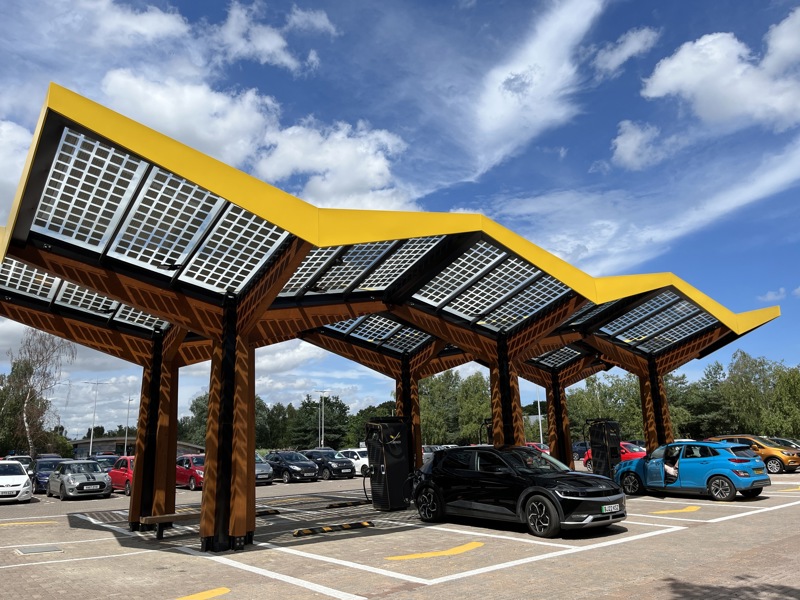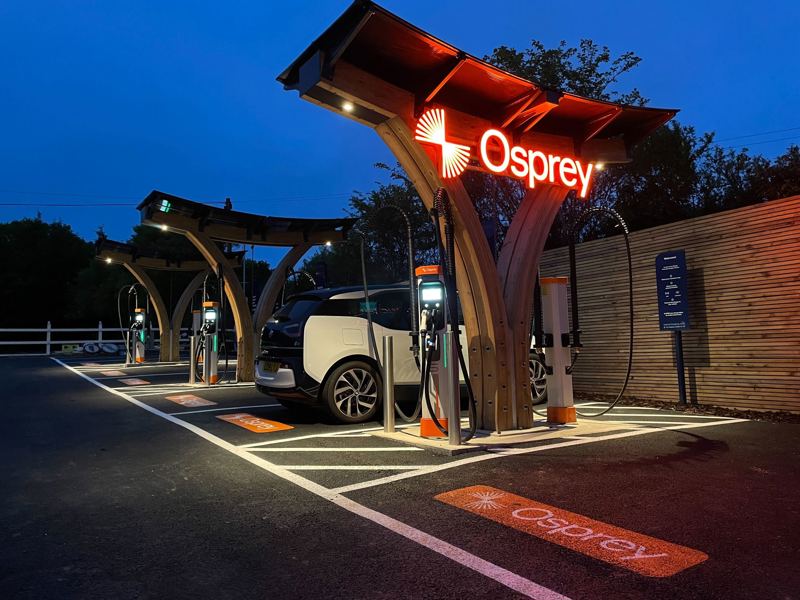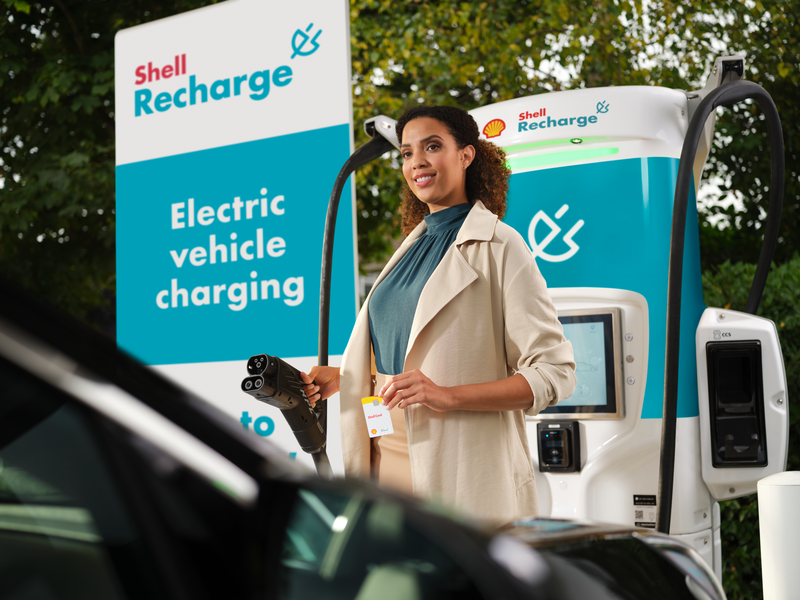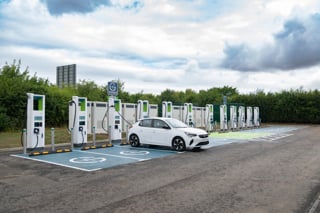This feature was taken from our special Electric Vehicle Charging Insight report.
Using the public rapid charging infrastructure has never been easier.
It has come a long way from just a few years ago when multiple apps and radio frequency identification (RFID) were needed to operate charge points on different networks.
Most of the networks do still have their own apps and there are advantages to using these, such as access to receipts and charging session details, while many offer subscriptions which unlock lower rates.
Often network providers offer specific programmes aimed at helping fleet managers simplify their transition to EVs, as well as their processes when running them.
However, for ad hoc charging sessions, drivers can now generally just turn up at a charger, pay with a contactless bank card and be on their way.
One drawback of this approach is the charge points do not have the capability to print receipts, so drivers and fleet decision-makers need to be aware of the processes in obtaining these.
In this feature we look at what some of the UK’s largest public rapid charger networks offer, as well as network size, cost to use and their growth plans.
GeniePoint, MFG EV Power and Applegreen Electric were also invited to take part in this feature, but failed to supply any information.

bp pulse
Number of charge points: bp pulse has more than 3,000 rapid (50kW) and ultra-fast (150kW) charging bays across the UK.
How much are they to use? Current tariffs are 77p/kWh for rapid (AC 43kW/DC50kW) chargers on a pay-as-you-go basis, while subscribers pay £0.63/kWh. Ultra-fast charging (DC 150kW+) chargers are 83p/kWh on a pay-as-you-go basis, while subscribers pay 69p/kWh. The company reviews prices in line with energy prices.
What is the process for getting a receipt? When drivers use the bp pulse app, they immediately see their transactions on there. Otherwise, customers can complete an online form on the company’s website and a receipt will be issued.
What fleet-specific products does bp pulse offer? bp pulse can build optimised charging plans for large fleet customers at a national scale. It also creates charging ecosystems for all its business customers that bring together depot charging - including Charging-as-a-Service and its Load and Energy Management software - along with access to its national on-the-go network and charging for employees at home.
What are bp pulse’s growth ambitions? In 2022, bp pulse announced plans to invest up to £1bn over 10 years in UK charging infrastructure. In 2023, it more than doubled the number of ultra-fast charging bays on its network and built the largest EV charging hub in the country at the NEC, in Birmingham (pictured above). It now plans to have hundreds more rapid and ultra-fast EV charging hubs across the UK by 2030.

Fastned
Number of charge points: Fastned operates more than 300 charging hubs across Europe, with more than 1,800 chargers. As of April 2024, Fastned's network in the UK consists of 120 chargers across 22 charging hubs. Its ultra-rapid charging hubs offer 300kW of power, and 400kW will soon be available at its newest hubs.
How much are they to use? Fastned’s pay-as-you-go tariff is currently £0.73/kWh. This is reviewed on a regular basis and may be adjusted in line with market developments. For drivers that charge with Fastned several times a month, it is possible to take out a gold membership, where drivers receive a 30% discount on its pay-as-you-go rate.
What is the process for getting a receipt? Fastned’s charging hub offers different payment methods. Drivers can pay using the Fastned app and receive a monthly invoice for all charging sessions.
Alternatively, they can pay through the contactless payment and get a receipt automatically by scanning the QR code. Those choosing to swipe a charge card need to check with their provider regarding the process for getting a receipt.
What fleet-specific products does Fastned offer? Fastned accepts fleet-specific chargecard providers such as Paua and Allstar.
What are Fastned’s growth ambitions? By 2030, Fastned aims to grow its total network to 1,000 charging hubs. It has a solid pipeline of new sites in the UK, with more opening every month.

Gridserve
Number of charge points: Gridserve’s Electric Highway now has more than 180 locations with more than 1,300 charging bays. The chargers range from low-power chargers of up to 22kW, medium power chargers of up to 90kW and high-power chargers of up to 350kW or dual chargers capable of up to 360kW.
How much are they to use? Gridserve currently charges 79p/kWh for DC charging and 49p/kWh for AC charging.
What is the process for getting a receipt? Receipts can be downloaded from a dedicated section on Gridserve’s website. Customers require the last four digits of the card they paid with. Regular users of the Electric Highway can sign up to automated charging receipts straight to their email inbox.
What fleet-specific products does Gridserve offer? Gridserve accepts Allstar One Electric card, Plugsurfing card and Paua. It will also be launching its first app later this year with benefits for fleet customers.
What are Gridserve’s growth ambitions? Last year Gridserve installed more than 300 charging bays added across Electric Super Hubs and Electric Retail Hubs, triple the number it opened in 2022. It is now planning to build on this success and has opened 90 new charging bays in the first three months of 2024.
Two new major Electric Forecourts are currently under construction, one site in Stevenage, in Hertfordshire, on the A1(M) and Markham Vale on the M1 in Derbyshire.

InstaVolt
Number of charge points: InstaVolt currently has 1,508 chargers across the UK. These are all speeds of 50kW+ with the majority of its network now 120kW and 160kW+. Going forward, InstaVolt will install only 160kW+ chargers.
How much are they to use? All InstaVolt chargers cost a flat fee of £0.85/kWh. Its prices are reviewed regularly to ensure they are in line with other rapid and ultra-rapid charging networks.
What is the process for getting a receipt? Drivers can obtain a VAT receipt by using the VAT receipt generator on its website. A driver needs to enter the details from their session into the relevant sections on the form, and this will provide them with a receipt which can be downloaded to print at home or submit to reclaim expenses.
What fleet-specific products does InstaVolt offer? Fleet managers can track and monitor fleet spending using their own personal dashboard. InstaVolt’s Fleet Account Solution also allows companies to monitor employees’ driving behaviour and spend.
This reporting system informs how long each driver is charging for and their own charging pattern – including frequent short stops versus long charging sessions. It also enables fleet managers to order and cancel cards, add new users and change card details.
Each card is registered to either a driver or vehicle using the vehicle registration number. It also offers a Fleet App, so drivers need only use their mobile phone to access an InstaVolt charger. InstaVolt can frequently also support fleets own RFID cards, if issued to drivers.
What are InstaVolt's growth ambitions? InstaVolt is currently gearing up for a new phase of growth to deliver on its commitment to install 11,000 ultra rapid chargers in the UK and Ireland by 2030.

Osprey Charging
Number of charge points: Osprey Charging currently has more than 1,000 high-powered charge points across Great Britain, from John O’Groats down to Cornwall. The speed of its chargers ranges from 50kW to 300kW.
How much are they to use? Osprey charges a flat rate of 79p/kWh, whether drivers pay by contactless bank card or Osprey app. It accepts a range of third-party fuel and fleet cards on its network which may charge a different rate.
The pricing is reviewed whenever there is a significant change in the elements that make up the cost of installing and running the network - including hardware, infrastructure, installation, electricity and operating costs.
What is the process for getting a receipt? For users of the Osprey App, charging history and VAT receipts are available for direct download from within the app. For customers who use a contactless bank card or wallet, Osprey’s website form automates receipts and emails them directly to the customer. Alternatively, Osprey’s in-house customer service team ensures customers receive their receipts within 48 hours of an emailed request.
What fleet-specific products does Osprey offer? Osprey accepts all major fleet roaming solutions - big or small - enabling charging sessions via app or RFID card and reconciling billing seamlessly through the fleet services provider.
For larger fleets, it offers bespoke integrations with the Osprey network. This enables drivers to use custom RFID cards for hassle-free charging on the Osprey network. It also operates its own Osprey App which provides benefits to smaller business drivers, such as direct access to downloadable VAT receipts.
Fleet managers using solutions like Allstar or Paua receive consolidated monthly invoices. All billing and payment reconciliation is handled automatically.
What are Osprey’s growth ambitions? Osprey Charging plans to add another 500 charge points to the network in high-powered hubs of eight, 12, 16 and more charge points.

Shell Recharge
Number of charge points: The Shell Recharge network provides access to more than 25,000 public charge points across the UK and more than 600,000 public charge points across Europe.
This includes more than 700 Shell Recharge branded charge points on Shell forecourts, hubs and at destinations such as participating Waitrose and Aldi supermarkets and more than 8,000 on-street charge points via Shell ubitricity.
How much are they to use? Current charges are 79p/kWh for fast (7-22kW AC) charging , while rapid/ultra rapid (50-175kW DC) costs 79p/kWh to 93p/kWh depending on location.
What is the process for getting a receipt? When paying with contactless or using the QR code at a Shell Recharge charge point, you can request a receipt by contacting customerservice@shellrecharge.com and providing these details:
- Date and time of transaction
- The total amount charged
- Last 4 digits of your credit / debit card
What fleet-specific products does Shell Recharge offer? All our solutions are powered by our Shell Card, which provides access to Shell and our partners’ networks of more than 3,800 traditional fuel forecourts and more than 25,000 EV charge points.
This also ensures both one card and one invoice for both fuel and EV transactions. The Shell Fleet Hub enables fleet managers to log into the Shell Card central hub for better oversight and control of EV card transactions and activity.
The Shell Fleet Hub allows them to view all Shell Card transactions; monitor costs including fuel and electric vehicle charge costs; and view and download invoices with all transactions consolidated in one place, including EV charging.
What are Shell Recharge’s growth ambitions? Shell is aiming for 90% of all drivers in the UK to be within 10 minutes of a Shell EV charger by 2035. It is investing in a range of different EV chargers that meet fleet drivers’ needs, depending on where they are and how long they're willing to spend charging.
For example, on its forecourts it offers faster charging from 50kW up to 360kW. Meanwhile, through its partnerships with other destinations, it is installing a mix of standard AC and fast DC chargers.

Smart Charge
Number of charge points: Smart Charge, which is fully-owned and managed by supermarket giant Sainsbury’s, currently offers 371 bays at 45 locations nationwide. They all offer at least 150kW, and some of its sites offer power outputs of 300kW for compatible EVs.
How much are they to use? Smart Charge currently charges 75p/kWh.
What is the process for getting a receipt? Customers can simply scan the QR code that is shown on the charger display screen using a mobile device. They can then track the progress of the charge and when it’s finished, they can view the receipt.
What fleet-specific products does Smart Charge offer? At the moment Smart Charge provides the same type of service for all compatible EVs and drivers.
What are Smart Charge’s growth ambitions? Smart Charge has said it will deploy 750 charging bays by the end of the year.
Charging is one of the biggest challenges faced by fleets and their drivers in the transition to full electric. In our latest Fleet News special report, we break down the challenges affecting each of the charging types - home, workplace and public - and provide advice and guidance to help you navigate your way through the EV transition journey.























martinwinlow - 09/07/2024 14:01
Not a single mention of Tesla? Seriously?! Talk about room-bound elephants! Clearly this article is not worth the electrons used in making it!